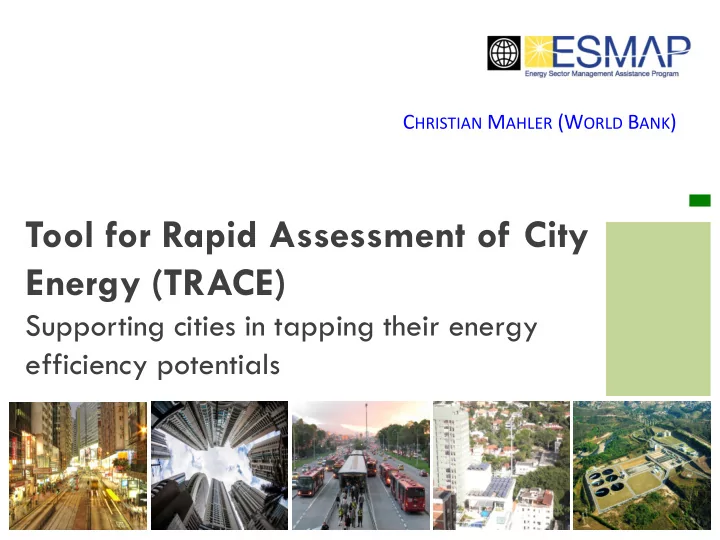

C HRISTIAN M AHLER (W ORLD B ANK ) Tool for Rapid Assessment of City Energy (TRACE) Supporting cities in tapping their energy efficiency potentials
Agenda I NTRODUCTION TO TRACE • E XPERIENCE FROM U KRAINE , B RAZIL , I NDIA AND K YRGYZ • R EPUBLIC 11/23/2015 2
TRACE – Tool for Rapid Assessment of City Energy A practical tool for conducting rapid assessment of energy use in cities, that identifies and prioritizes sectors and suggests specific energy efficiency interventions… Sector coverage: transport, buildings (new: residential and commercial buildings), public lighting, water & wastewater, power & heating, solid waste, industry (new) Sector Intervention Energy Efficiency Assessment Recommendations Models 11/23/2015 3
What’s new? The update takes stock of the lessons learnt from over 60 TRACE deployments worldwide Three new sectors : residential and commercial buildings as • well as urban industry About 100 built-in recommendations • Offers full spectrum of guidelines and case studies to deliver • EE interventions , such as PPP , leasing, municipal financing, ESCO financing Upon determining sector recommendations TRACE allows • financial analysis through built-in intervention models (calculators) Updated data for 97 cities worldwide • 11/23/2015 4
TRACE architecture 11/23/2015 5
1. On-site data collection 11/23/2015 6
2. Benchmarking Selection of 10-12 peer cities with a similar climate and level of development gives an idea of the relative potential for energy efficiency Beware of wrong conclusions as local peculiarities might skew results (e.g. down-hill flow of potable water might significantly reduce electricity consumption for pumps) 11/23/2015 7
3. Sector prioritization Purpose • Sheds light on sector control and potential EE benefits for City Authority • Weights energy efficiency potentials and savings • Identifies energy spending hotspots and potential energy efficiency savings Calculation Relative Energy X X City Authority Energy Spending Control Intensity 11/23/2015 8
4. Selection and fine-tuning of recommendations 11/23/2015 9
5. Intervention model E STIMATING THE C OSTS AND B ENEFITS OF EE I NTERVENTIONS 11/23/2015 10
APPROACH IN THE BUILDING SECTOR EXPERIENCE FROM UKRAINE, INDIA, BRAZIL AND KYRGYZ REPUBLIC 11/23/2015 11
Entry points for urban energy diagnostics Enhanced understanding of energy use challenges and potentials to inform future policy and urban planning processes or support the development of an urban sustainability agenda Identifying and prioritizing sectors with high energy efficiency potentials and quick returns to showcase viability of urban energy efficiency and improve service delivery to city dwellers Providing a set of implementable and tailored recommendations that can be used to develop an investment pipeline or inform the municipal investment plan Mainstreaming energy efficiency and sustainability into the institutional structure of the city, e.g. by a city-wide procurement policy 11/23/2015 12
Experience from India and Ukraine Engagements in the three cities of Bhubaneswar, Cuttack and Puri in Odisha, India taught us that a tool needs to anticipate future urbanization growth and associated challenges such as increasing cooling demands and construction of residential buildings TRACE deployments in the cities Kiev, Ternopil and Kamianetsk-Podilskyi in Ukraine revealed enormous energy efficiency potentials in the public and residential building sector and highlighted need for sound national-level legislation (ESCO and HOA laws) 11/23/2015 13
Experience from Brazil and Kyrgyz Republic In Kyrgyz Republic TRACE was used to inform municipal energy savings plans and select public buildings for piloting retrofits to significantly reduce electricity consumption, TRACE opened-up dialogue opportunities and revealed that capacity building was necessary for building sector stakeholders For Belo Horizonte in Brazil TRACE provided the city administration with an understanding of consumption patterns and helped them to subsequently introduce electricity consumption monitoring for public buildings and a Sustainable Building Certification Program for residential and commercial buildings 11/23/2015 14
Lessons learnt from TRACE deployments Experience shows that ability of city administrations to facilitate changes (through policies or investments) varies across countries and even cities Because urban energy challenges can be very diverse even within the same country a broad range of measures (investment, non-investment) should be considered Usually the need for intervention is not limited to city-level but also requires central government to get involved (e.g. energy subsidies, budget codes, etc.) While TRACE provides analysis and intervention guidance another great feature is that it offers an opportunity for dialogue with a city and cross-departmental exchange Urbanization rates need to be taken into account 11/23/2015 15
C HRISTIAN M AHLER CMAHLER @ WORLDBANK . ORG Thank You. The World Bank | 1818 H Street, NW | Washington DC, USA www.esmap.com | esmap@worldbank.org
Recommend
More recommend